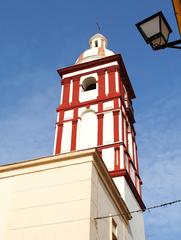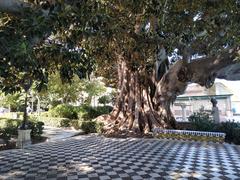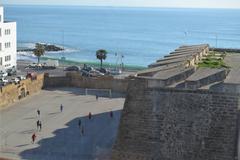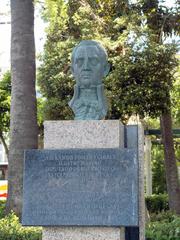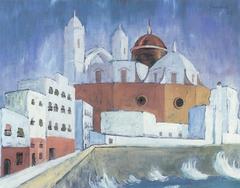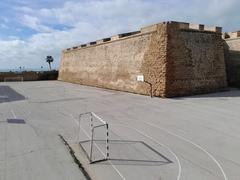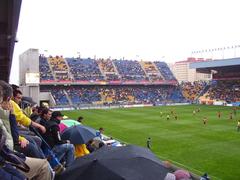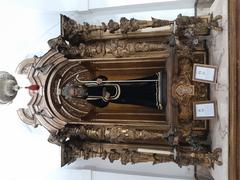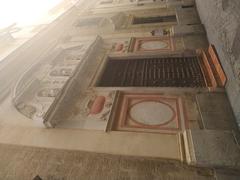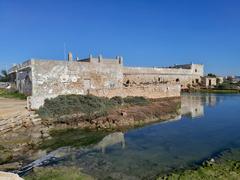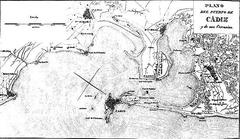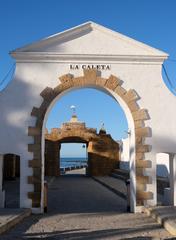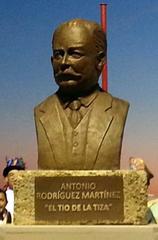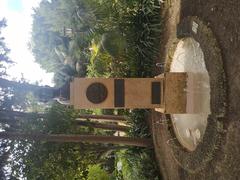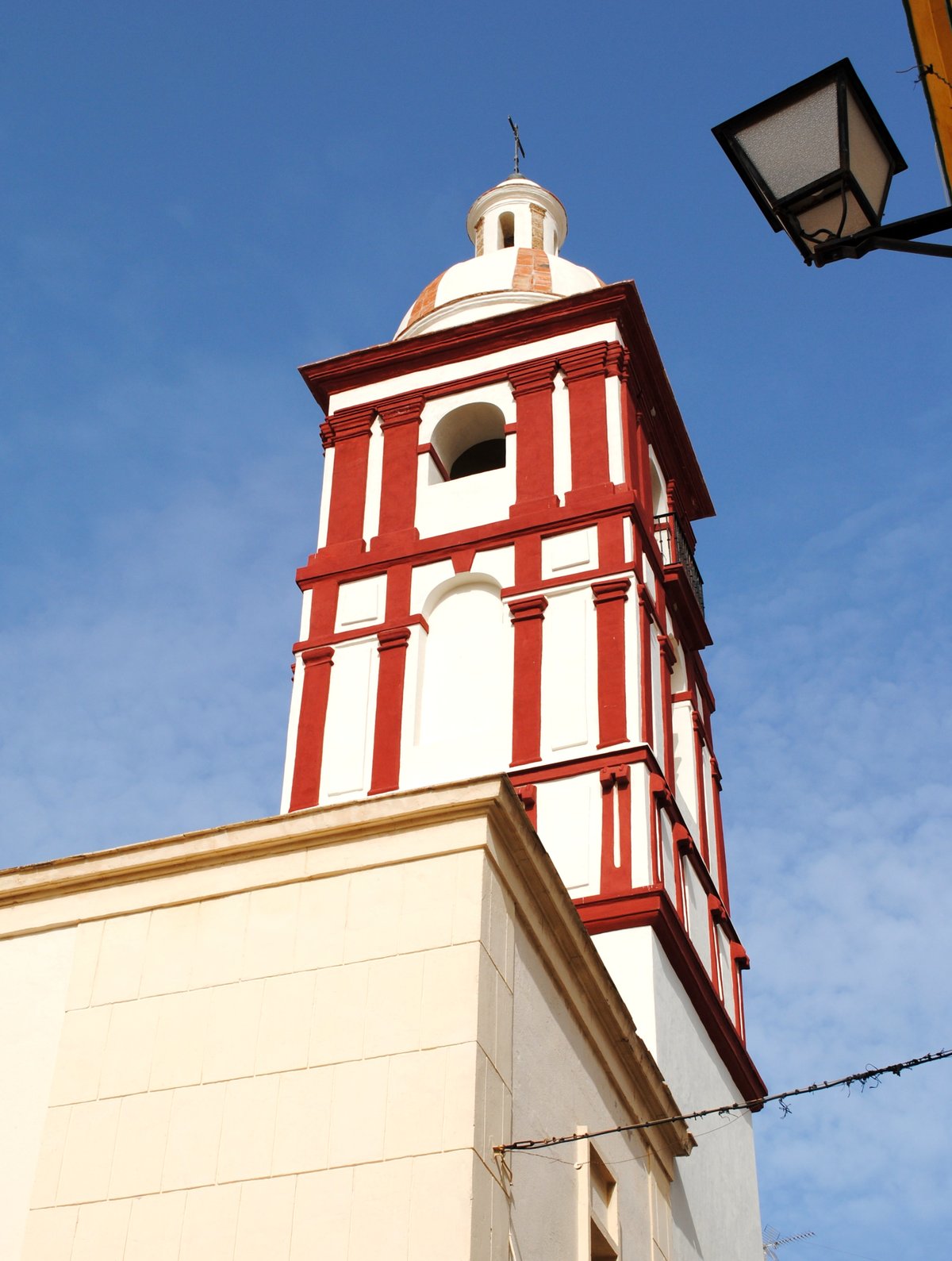
Torre y Portada de la Iglesia de la Merced, Cádiz: Visiting Hours, Tickets & Travel Guide
Date: 14/06/2025
Introduction
Nestled in Cádiz’s historic heart, the Torre y Portada de la Iglesia de la Merced stands as a vivid testament to the city’s Baroque heritage and religious traditions. Founded in 1629 as part of the Mercedarian convent, this remarkable church showcases centuries of spiritual, cultural, and architectural evolution, reflecting Cádiz’s unique identity as one of Europe’s oldest cities. Today, its protobarroque bell tower and intricately decorated main façade offer visitors an immersive glimpse into 17th-century Andalusian design and the enduring legacy of the Mercedarian mission (Guía de Cádiz, What Cádiz).
Beyond its architectural features, the Iglesia de la Merced plays a vibrant role in Cádiz’s religious life, hosting processions and cofradías, especially during Holy Week and the feast of the Virgen de la Merced on September 24. Despite historical challenges—including secularization and a devastating fire in 1936—the church has been carefully restored, preserving treasures such as the polychrome altarpiece by Torcuato Cayón and sculptures by Mariano Benlliure (Semanasantacadiz, Wikipedia).
This comprehensive guide provides detailed insights into the church’s history, architecture, cultural significance, and practical visitor information—including opening hours, accessibility, guided tours, and nearby attractions. Whether you are a history enthusiast, architecture lover, or cultural traveler, exploring the Torre y Portada de la Iglesia de la Merced is an essential Cádiz experience. For updated details and immersive resources, consult the Audiala app and official Cádiz tourism platforms (Cadiz.es Turismo).
Table of Contents
- Introduction
- Historical Overview
- Architectural Highlights
- Cultural and Religious Significance
- Visitor Information
- Restoration Efforts
- Related Attractions & Travel Tips
- FAQs
- References
Historical Overview
Origins and Foundation
The church traces its origins to the early 17th century, when the influential Duques de Medina Sidonia and prominent Cádiz citizens supported the foundation of the Mercedarian convent in 1629 (Guía de Cádiz). The Mercedarian order, established in Barcelona in 1218, was dedicated to the redemption of Christian captives and played a vital role in Cádiz’s religious and social fabric. The convent’s location in the Santa María district reflected Cádiz’s prosperity and cosmopolitan spirit as a major Atlantic port (What Cádiz).
Architectural Development & Features
Over time, the original complex underwent significant transformations, especially following 19th-century secularization laws that led to the loss of the convent and much of the nave. Today, the most significant surviving elements are the main façade and the bell tower—outstanding examples of Andalusian protobarroque architecture (Guía de Cádiz).
The Tower (Torre)
The square-plan bell tower is adorned with Tuscan pilasters and capped by a hemispherical dome and lantern. Its restrained Baroque style bridges Renaissance solidity and Baroque decorative ambitions, serving both as a spiritual beacon and a visual landmark (Guía de Cádiz).
The Façade (Portada)
The main portal features three sections, with Tuscan pilasters, a broken curved pediment, and a relief of the Virgen de la Merced. This vertical composition enhances the church’s presence and underscores Marian devotion, a hallmark of Cádiz spirituality (Guía de Cádiz).
Historical Transformations
The Mercedarian church and convent long served as centers of worship, charity, and education. After the 19th-century Desamortización, much of the complex was lost, but the remaining tower and façade survived as cultural touchstones. In the 20th century, the church experienced a revival, with the creation of a new image of the Virgen de la Merced and renewed parish life (Semanasantacadiz).
Architectural Highlights
Exterior: Tower and Façade
The tower stands as a prominent vertical element on the Cádiz skyline, its Baroque design characterized by a robust base, ornate belfry, and elegant dome. The façade combines Solomonic columns, sculpted niches, and intricate stonework, integrating religious symbolism and artistic flourish (iglesiaslocales.com).
Interior: Nave, Altar, Dome
Inside, the nave features a barrel-vaulted ceiling, polychrome decoration, and side chapels illuminated by stained glass. The main altar is dominated by a gilded retablo attributed to Torcuato Cayón, housing images of the Virgen de la Merced and other saints. Above the crossing, a painted dome with a lantern bathes the sanctuary in natural light, while frescoes and gilded moldings evoke Andalusian Baroque splendor.
Decorative Arts & Symbolism
The church showcases polychrome sculptures, religious paintings, wrought-iron grilles, and intricately carved woodwork, blending Moorish and Christian influences. Each element is designed to inspire awe and convey the Mercedarian mission.
Cultural and Religious Significance
Mercedarian Foundation
The church and convent, established by the Mercedarian order with support from Cádiz’s elite, became vital to local spiritual and social life, especially during periods of crisis and conflict (Wikipedia).
Religious Devotion & Cofradías
Devotion to Nuestra Señora de la Merced is central, with the church serving as headquarters for historic brotherhoods such as Sentencia and Siete Palabras. These cofradías organize processions during Holy Week and other religious festivities, attracting both locals and visitors (Semana Santa Cádiz).
Artistic Heritage
Key artistic highlights include the pre-Baroque façade, the square bell tower, and a polychrome retablo with a Dolorosa by Benlliure, all reflecting the evolving role of art in Cádiz’s religious expression (Guía de Cádiz).
Social and Cultural Impact
The site has served not only as a place of worship but also as a community hub—housing a school and supporting charitable missions—especially after secularization (Obispado de Cádiz y Ceuta). The church remains a space of resilience, memory, and community identity.
Visitor Information
Opening Hours
- Monday to Saturday: 10:00 AM – 1:30 PM and 5:00 PM – 7:30 PM
- Sunday & Public Holidays: 10:00 AM – 1:30 PM
(Hours may be subject to change during special events or religious festivals; confirm with the parish or tourism office before visiting.)
Tickets & Admission
- Admission: Free (donations welcome for preservation efforts)
Accessibility
- Main entrance and nave: Accessible to visitors with reduced mobility
- Tower: Not open to the public, and not wheelchair accessible
Guided Tours
- Guided tours are available by arrangement through the parish or Cádiz tourism office, offering detailed insights into the church’s history and art.
Location & Transportation
- Located in the Santa María district, the church is within walking distance of Cádiz Cathedral, Plaza de San Juan de Dios, and public transport hubs. Limited parking is available nearby; walking or public transit is recommended.
Special Events
- The feast of the Virgen de la Merced (September 24) and Holy Week processions are highlights of the church’s annual calendar (Semanasantacadiz).
Photography
- Visitors are encouraged to photograph the façade, tower, and interior (without flash), especially during daylight for optimal lighting. Please respect the sacred atmosphere during services.
Restoration Efforts
Ongoing conservation and restoration projects aim to preserve the church’s historical and artistic heritage. Recent efforts have focused on stabilizing the tower and restoring decorative elements, reflecting Cádiz’s commitment to safeguarding its cultural legacy (Obispado de Cádiz y Ceuta).
Related Attractions & Travel Tips
- Nearby sites: Cádiz Cathedral, Roman Theatre, Castillo de San Sebastián, Barrio del Pópulo
- Best time to visit: Early mornings or late afternoons for fewer crowds and optimal light
- Travel tip: Explore the Santa María district for local cafés and photo opportunities, and use the Audiala app for interactive guides.
Frequently Asked Questions (FAQ)
Q: What are the visiting hours?
A: Monday to Saturday: 10:00–13:30 and 17:00–19:30; Sundays and holidays: 10:00–13:30.
Q: Is there an entrance fee?
A: No, admission is free; donations are appreciated.
Q: Are guided tours available?
A: Yes, by reservation through the parish or tourism office.
Q: Is the church accessible?
A: The main entrance is accessible; the tower is not open to visitors.
Q: When are special events held?
A: The feast of the Virgen de la Merced (September 24) and Holy Week.
Summary & Final Tips
The Torre y Portada de la Iglesia de la Merced in Cádiz is more than an architectural landmark—it is a living symbol of the city’s historical resilience, religious devotion, and artistic accomplishment. From its 17th-century origins to its survival through fires, secularization, and restoration, the church reflects the layered history of Cádiz. Its Baroque tower and façade captivate visitors and embody the spiritual dedication of the Mercedarian order and the local community (Guía de Cádiz, Semanasantacadiz).
Plan your visit to immerse yourself in Cádiz’s unique blend of history, art, and community spirit. Use the Audiala app and official tourism channels for the latest updates on events and visiting conditions (Cadiz.es Turismo). Discover the enduring spirit of Cádiz through this magnificent church—where every stone and sculpture tells a story.
References
- Guía de Cádiz
- What Cádiz
- Semanasantacadiz
- IglesiasLocales.com
- Wikipedia
- Cadiz.es Turismo
- Obispado de Cádiz y Ceuta
- Mapcarta - Plaza de la Merced, Cádiz
- Urbipedia: Iglesia de Nuestra Señora de la Merced (Cádiz)
- Cadiz Cofrade
